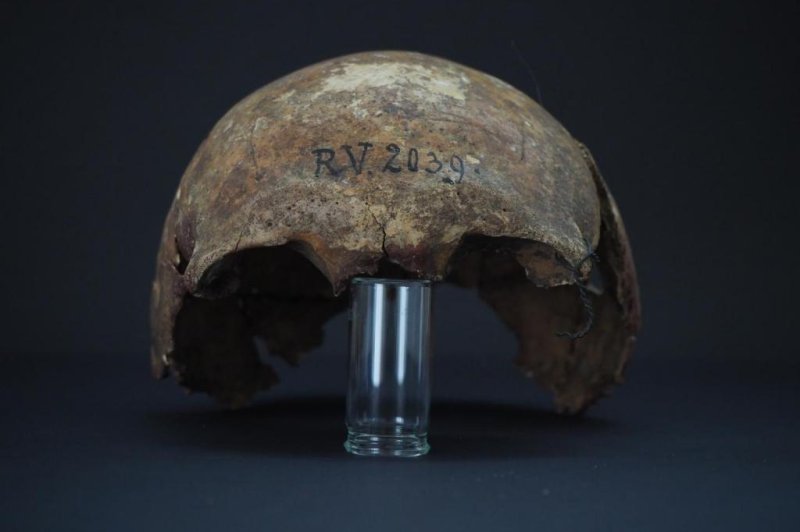
The skull of a 5,000-year-old hunter-gatherer found in Latvia in the 1800s, pictured, contains the oldest strain of the bacteria causing bubonic plague ever found. Photo by Dominik Göldner/Berlin Society for Anthropology, Ethnology, and Prehistory
The Black Death was stalking people thousands of years earlier than previously known, new evidence reveals.
The oldest strain of Yersinia pestis -- the bacteria behind the bubonic plague that may have killed as much as half of Europe's population in the 1300s -- has been found in the remains of a 5,000-year-old hunter-gatherer, researchers report.
The skeleton of the 20- to 30-year old man was unearthed in the late 1800s in a region of Latvia called Rinnukalns. But the skeleton soon vanished, only to reappear in 2011 as part of an anthropologist's collection.
A genetic analysis revealed the presence of a strain of Y. pestis that likely killed the man, even though scientists think it was less contagious and less deadly than the medieval strain.
RELATED Plague transmission rates increased from the Black Death to the Great Plague
After comparing it to other ancient strains, the researchers concluded that the strain in this hunter-gatherer is the oldest found to date.
It likely belonged to a lineage that emerged about 7,000 years ago, a few hundred years after Y. pestis split from its predecessor, Yersinia pseudotuberculosis, according to the authors of the study published Tuesday in the journal Cell Reports.
"What's most astonishing is that we can push back the appearance of Y. pestis 2,000 years farther than previously published studies suggested," said senior author Ben Krause-Kyora, head of the aDNA Laboratory at the University of Kiel in Germany.
RELATED Think 2020 was bad? Historians say 536 was worst year ever to be alive
"It seems that we are really close to the origin of the bacteria," he added in a journal news release.
The researchers also found that the newly identified strain lacked the gene that enables fleas to act as vectors to spread the bacteria to and between humans. It likely took thousands of years for Y. pestis to develop all the mutations needed for flea-based transmission.
Learning more about the history of Y. pestis could provide new insight into human genetics, according to the researchers.
RELATED Study: Cancer far more common in medieval times than thought
"Different pathogens and the human genome have always evolved together. We know Y. pestis most likely killed half of the European population in a short timeframe, so it should have a big impact on the human genome," Krause-Kyora said.
"But even before that, we see major turnover in our immune genes at the end of the Neolithic Age, and it could be that we were seeing a significant change in the pathogen landscape at that time as well," he added.More information
The U.S. Centers for Disease Control and Prevention has more on plague.
Copyright © 2021 HealthDay. All rights reserved.

No comments:
Post a Comment